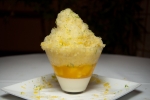Hawaii’s Go-To Dessert Gets a Shave and a Haircut

It's a tourist trap treat for some, revered post-plate lunch dessert for others. Saccharine, tooth-tingling shaved ice is as much a remnant of Hawaii's not-so-healthy past as it is a link to its influx of Japanese immigrants.
But at Alan Wong's, a culinary temple on Oahu devoted to giving the islands' low-end foods a boost of refinement, the dessert was one of Pastry Chef Michelle Karr-Ueoka's prime targets for an upgrade.
The original Japanese version, kakigori, is essentially a boardwalk-style snow cone, topped with syrups, ice cream, as well as condensed milk or red bean paste in some cases. Taking it up a few notches could have been a simple task; Wong already had an oyster shaved ice granité on his menu. But Karr-Ueoka, who still has fond memories of eating shaved ice with her Japanese grandmother, didn't want to take the easy path. "I always wanted to do a shaved ice. But I didn't want to do a granité approach because it's not different enough," she says. For her, shaved ice "speaks Hawaii" and deserved more.
Karr-Ueoka sat down with boss and mentor Alan Wong (who worked on a pineapple plantation when he was younger) to come up with the idea of compressing and freezing pineapple. In lieu of mochi balls, a common shaved ice topping, she decided to include tapioca pearls, which are an ode of sorts to both the Filipino version, halo-halo, and to Portuguese settlers. Instead of vanilla ice cream, she scooped in haupia sorbet and vanilla panna cotta. A bit of spectacle capped the dish, with threads of the frozen pineapple microplaned over the dessert like strands of sweet-sour Muppet hair.
Not just a testament to Hawaii's multi-ethnic culture, Karr-Ueoka's update is also a (relatively) healthy alternative to many of Hawaii's fat- and sugar-laden desserts. Take away the panna cotta, and the shaved ice is vegan. And the sugar content is mitigated by the natural sweetness of the local Kunia pineapples, which have high Brix levels (as high as 23 degrees) and less acidity than Maui or mainland versions. "Maui is not as hot as Kunia, so their pineapples are not as sweet," Karr-Ueoka says. "A lot of their pineapples were grown on chocolate or sugar plantations, so they take on the terroir of those areas."
Her pineapple shaved ice is her most famous, but Karr-Ueoka has dabbled with other fruity variations, each requiring its own technique. She compresses and freezes mango and strawberries, and she makes an avocado-lime paste to shave over the sorbet. She also experimented with caramelizing, compressing, and freezing Hawaiian bananas, but her bananas-foster version didn't quite work out. "The banana oxidizes when it sits in the freezer and turns brown," she laughs. "Chef [Wong] says that when I grate it, it looks like dog poop."
Like a performance artist with edible output, Karr-Ueoka has brought her famous shaved ice to New York City's Lucky Rice festival, a cancer fundraiser in Ohio, and countless food festivals in Hawaii. She boasts that she's sometimes cranked out more than 1,200 of the desserts in a single night—though often with the help of a few line cooks (and, on occasion, husband and fellow Alan Wong's employee, Chef de Cuisine Wade Ueoka).
Pineapple Shaved Ice Technique:
1. Clean and quarter each pineapple and cut out the core.2. Place the pineapple in a large bowl and mix with the scraped interior of a vanilla bean pod.
3. Vacuum-seal the pineapple quarters in bags with pieces of ginger and place in the freezer.
4. Using a coarse microplane, shave the frozen, compressed pineapple on top of haupia sorbet (or vanilla ice cream). Zest some lime peel with a microplane over top.










